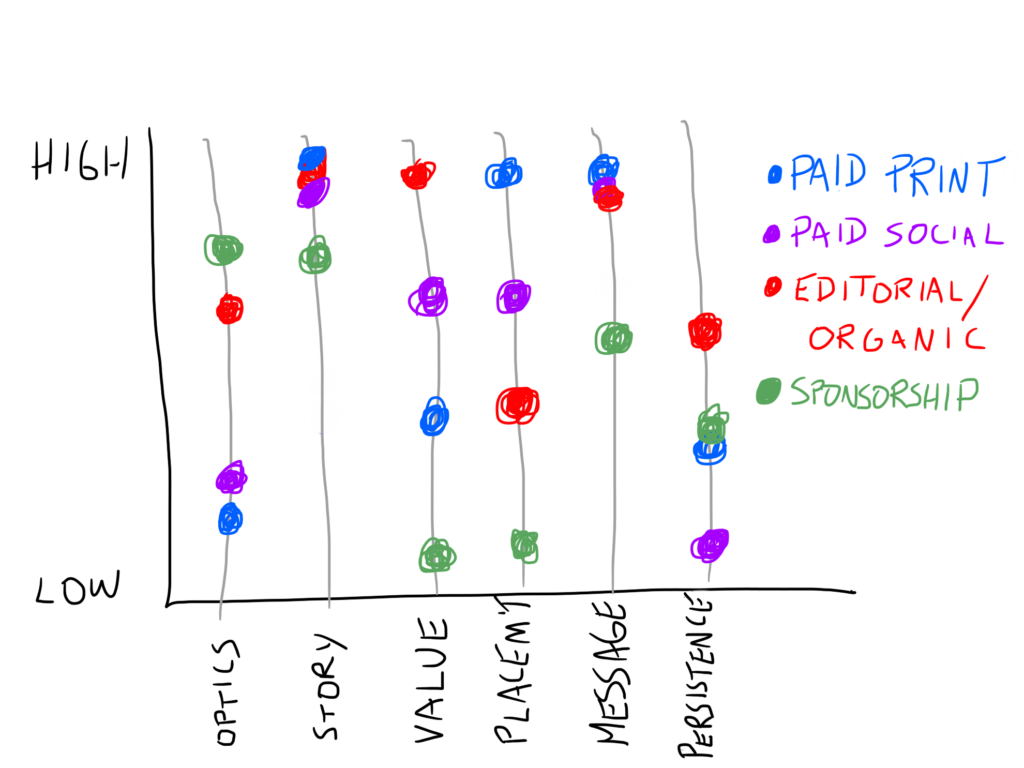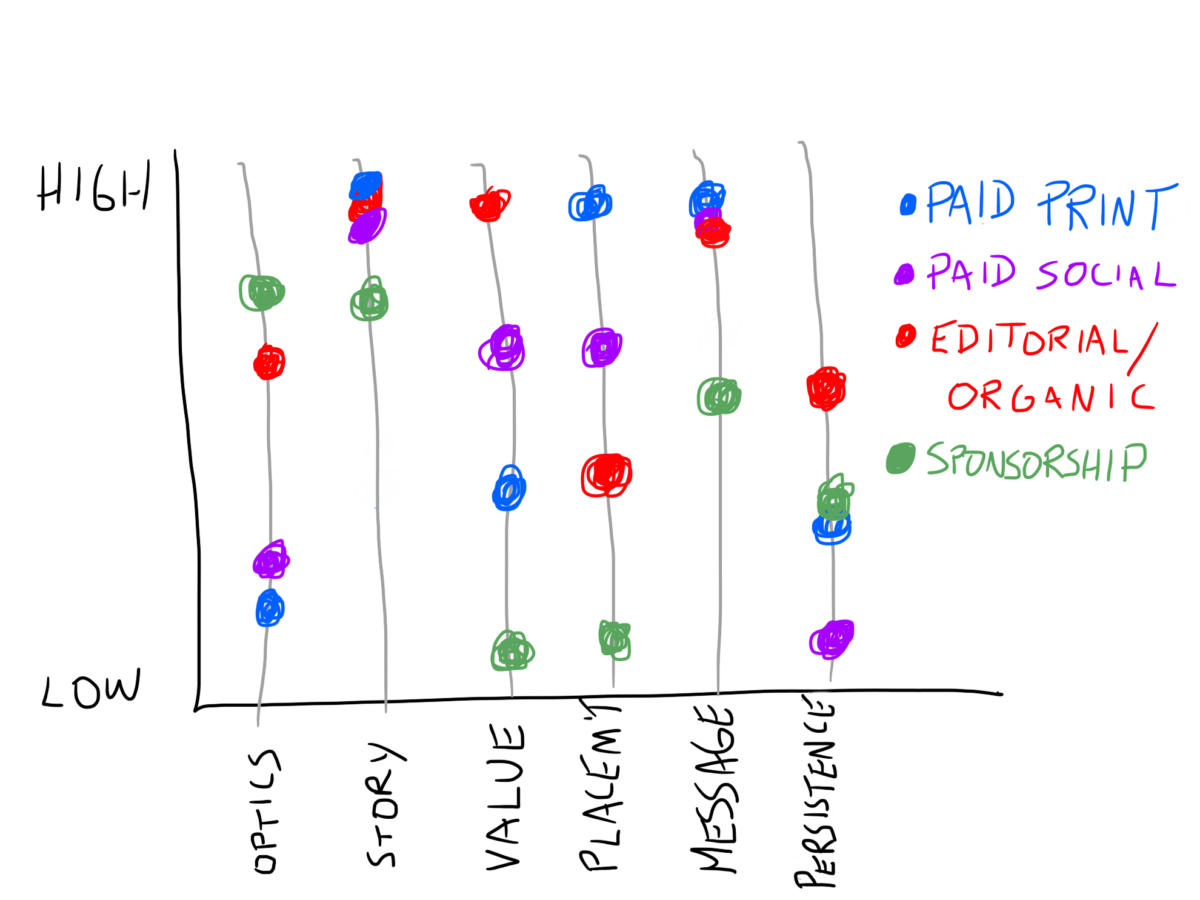When I started my Best Job Ever in July, I took over a marcomms shop run by somebody who had done it for 11+ years, and the circumstances of their leaving were less than ideal. There wasn’t a lot of leftover explanation of processes and systems; given that vacuum, there was also some reshuffling to move things into the marketing and communications shop that didn’t reside there before I started.
One of those things has been sponsorship. It’s going to be part of my budget; I’ve got a medium priority (i.e., back half of 2021) to come up with a comprehensive strategy around sponsorships.
There’s a natural fit there: one of the outputs of sponsorship is recognition. So why not put the people most in charge of our public-facing presence in charge of sponsorship?
My office is best positioned to analyze the optics and media value of a sponsorship. I know how much an ad costs in a national newspaper; I know how much it costs to produce a video; I know the rates for advertorial space in specialty magazines. Sponsorship, with “your logo goes here” and “we’ll mention you in our press releases thusly,” fits right into that matrix.
The difference between the former things and the latter things, though, is that media impact is the sole point of conventional paid media placement.
Even that’s not precisely true. There’s an optics and support component as well, in terms of what you chose to affiliate with in a media buy. I wouldn’t counsel us buying ads on a white-nationalist website, for instance; in fact, we have specific exclusion protocols set up ourselves and with media companies for this reason, so that when Google (for instance) is automatically placing ads, they don’t wind up anywhere nefarious. Social media channels are also on their way to their own kinds of polarization, where presence in one channel sends a message about the nature of your organization as well as the content in the message itself (Marshall McLuhan, I can’t quit you). A video on TikTok sends an inherently different message about who you’re speaking to and why than the same video on Twitter (and I’d argue that they shouldn’t be the same video anyway).
Fuzzily diagrammed — I’m still working through this, mentally, so don’t pay too much attention to it. Back of the napkin chicken scratch as I work through this.

We’ve got:
- Paid placement (print and social)
- Editorial and organic content (web, print, social)
- Sponsorships
And the outputs:
Optics: do we look good through our presence here? This is very high for sponsorships (the appearance is generosity), lower for editorial (we’re obviously self-motivated to be telling these stories), quite low for paid (it’s transparent that we’re spending money to say this thing).
Story: how much fidelity is there to an overall narrative? Do we control it? Pretty much a three-way tie at the top here, but sponsorship fares worse: we’re telling our story through the sponsor’s lens, and that carries more inherent risk.
Value: if you came in and plunked a stack of cash on my desk, how would I spend it? This is something we could spend a lot of time on, but my approach to structuring and building a shop that creates and sustains narrative is (obviously) that capacity to create and disseminate editorial/organic content is far and away the best bang for your buck. Then social’s better than print for specific targeting reasons, then print, and sponsorship justifiably at the bottom — you’re not paying for marketing, you’re paying for the organization to do what they do. A key part of this in the sponsor relationship is that getting value out of the sponsorship often requires the same capacity load as just running editorial and organic content.
Placement: how precisely do you control where your message ultimately appears? Print offers total control, social offers targeting but more fuzziness in exchange for spread, editorial/organic is at the mercy of those who share it, and sponsorship is largely ultimately out of your hands.
Message: Do you control the precise message you’re sending? Again, a three-way tie for paid / editorial / organic, and sponsorship fares worse.
Persistence: what endures over time? Only editorial, through SEO and ongoing web presence, really endures. Print advertising, paid social, sponsorships — all pretty ephemeral, social the fastest to vanish.
Caveat: I literally came up with this in 15 minutes on a Sunday morning, so don’t lose too much sleep over it. I can poke a bunch of holes in this myself on quick review, but I think it holds together in broad strokes.
So what’s the point?
“I believe in what you’re doing and want to give you money to support it” is the heart of a sponsor relationship. The more you drive sponsorship decisions into the marketing sphere, the more transactional the relationship will become, and — I’d argue — the higher the risk that the organization you’re sponsoring will become worse at what they do because their efforts turn more and more toward generating ROI opportunities for sponsors than pursuing their core mandate.
There’s no shortage of voices trying to encourage — or force — the relationship. Articles like this one present sponsorship as a marketing activity.
When you put that decision in my hands, however, you’re asking me for a professional evaluation based broadly on three things:
- Optics — how does it look for us to be supporting this?
- FOMO — who else is in? How does it look for us not to be present?
- Storytelling — what value can we generate by talking about this ourselves?
- Does that story mesh with a strategic, overaching goal of ours?
- Value adds — what will the organization do to promote our brand and story?
- Will this be a resource the organization can generate, or will it take capacity and collateral on my end for them to fulfil that part of their mandate?
This is all well and good — it’s a reasonable matrix for evaluation of a spend — but you’ll notice that nowhere in there do we see “are they doing work that is good and of value, and that we want to support”. It’s kinda in the “optics” category, but optics is just as much about the organization’s media presence and recognizability, how readily understandable their work is, and so on.
It’s sponsorship as fast carbs: an approach that prioritizes looking at short-term or immediate gain and not at ideals or long-term prospects.
As much as it removes things from my control, I am, on balance, a bigger fan of the other approach: the Dean or other senior admin make values-based judgments on what we want to sponsor and support, and there’s a hand-off that says “make the most of this from an optics and marketing perspective.”
I’m pro-sponsorship. Avidly so. I just think it’s best supported for reasons that start with mission and values, and not originating through the marketing lens.
This tail-wags-dog approach doesn’t align well with my ideals and ideas around what sponsorship could and should be. It can work, and I’ll make it work, because that’s what I do, but the aforementioned report on sponsorship planning will be a solid matrix of what we get from sponsorships, in terms of optics, marketing, communications and partnerships… and a full-throated defense of doing things that other way, where the institution supports and aligns with organizations that meet its mission and goals first, and marketing becomes a byproduct of sponsorship, instead of the primary driver.
In the interim, if you’re doing great things in the engineering space and want sponsorship, hit me up! I can’t promise much — the budget is small! — but the more data points I can get into the “mercantile” matrix, the better it’ll be when I make the case for sponsorship to be a function of ideology, not direct benefit.
